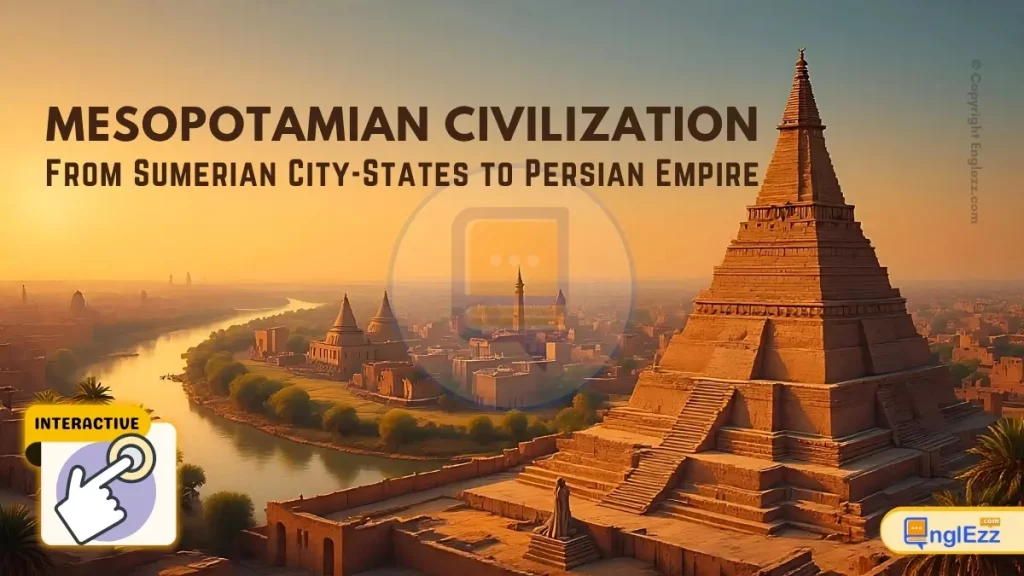The Journey Of Mesopotamian Civilization Through Time
From Sumerian City-States to Persian Empire
Introduction
MESOPOTAMIA: The Cradle of Civilization
Mesopotamia, the land between the Tigris and Euphrates rivers, is often called the “Cradle of Civilization” as it was home to some of the earliest complex societies in human history. This region, located in modern-day Iraq and parts of Syria, Turkey, and Iran, witnessed the rise of city-states, the invention of writing, and the development of sophisticated legal and political systems.
Over three millennia, Mesopotamia saw successive civilizations rise and fall, each contributing to the cultural and technological foundations of the ancient world. From the Sumerians who developed cuneiform writing to the Babylonians who established Hammurabi’s famous law code, Mesopotamian innovations shaped the course of human development.
Sumerian Period
The Sumerians established the world’s first cities around 4000 BCE, developing writing (cuneiform), the wheel, and complex irrigation systems. Their city-states like Ur, Uruk, and Lagash were centers of trade, religion, and political power. Sumerian mythology and literature, including the Epic of Gilgamesh, represent some of humanity’s earliest literary works.
Akkadian Empire
Sargon of Akkad created history’s first empire around 2334 BCE, uniting the Sumerian city-states under Akkadian rule. The empire established centralized government and spread Semitic languages throughout Mesopotamia. The Akkadians adopted and adapted Sumerian culture while expanding trade networks across the ancient Near East.
Persian Period
The Achaemenid Persian Empire conquered Mesopotamia in 539 BCE, incorporating it into the largest empire the world had yet seen. Under Persian rule, Mesopotamia remained an important administrative and economic center. The Persians introduced new administrative systems and infrastructure while generally respecting local traditions and religions.
Explore the interactive Mesopotamian civilization timeline below to discover key events that shaped this ancient world. Click on any event to learn more, and test your knowledge with our quiz when you’re ready!
Interactive Mesopotamian Civilization Timeline
Invention of Cuneiform Writing
The Sumerians develop cuneiform, one of the earliest known writing systems, initially for accounting purposes but later for literature and law.
Cuneiform, meaning “wedge-shaped,” was developed by the Sumerians of southern Mesopotamia around 3500 BCE. The writing system began as pictographs but evolved into abstract wedge-shaped marks made by pressing a reed stylus into clay tablets. Initially used for recording economic transactions, cuneiform was later adapted for literature, law, science, and diplomacy.
The earliest known cuneiform tablets come from the city of Uruk and document administrative activities like grain distribution and trade. Over time, the system became more sophisticated, capable of representing the Sumerian language phonetically. Cuneiform was later adapted to write other languages of the region, including Akkadian, Elamite, and Hittite.
Key literary works preserved in cuneiform include the Epic of Gilgamesh, the world’s oldest known epic poem, and the Code of Ur-Nammu, one of the earliest known law codes. The decipherment of cuneiform in the 19th century opened a window into ancient Mesopotamian civilization and confirmed many historical events recorded in the Bible.
Further Reading
- Walker, C.B.F. Cuneiform (1987)
- Nissen, Hans J. The Early History of the Ancient Near East, 9000-2000 B.C. (1988)
Ur-Nammu’s Law Code
Ur-Nammu, king of Ur, establishes one of the earliest known law codes, predating Hammurabi’s more famous code by about 300 years.
Read moreThe Code of Ur-Nammu, dating to approximately 2100-2050 BCE, is the oldest known law code surviving today. Established by Ur-Nammu, founder of the Third Dynasty of Ur, the code represents an early attempt to create a standardized legal system across the Sumerian city-states.
Unlike the later Code of Hammurabi which followed the principle of “an eye for an eye,” Ur-Nammu’s code prescribed monetary compensation for bodily injuries. For example, it states: “If a man knocks out the tooth of another man, he shall pay two shekels of silver.” The code also established standardized weights and measures and protected the poor from usury.
The prologue to the code describes how Ur-Nammu established justice in the land after the chaos of the Gutian invasion. The laws covered various aspects of society including marriage, slavery, agriculture, and commerce. Though only about 40 of the original laws survive, they provide valuable insight into Sumerian society and legal thought.
Further Reading
- Roth, Martha T. Law Collections from Mesopotamia and Asia Minor (1995)
- Kramer, Samuel Noah. The Sumerians: Their History, Culture, and Character (1963)
Rise of Sargon of Akkad
Sargon establishes the Akkadian Empire, history’s first known empire, uniting the Sumerian city-states under his rule.
Sargon of Akkad (reigned c. 2334-2279 BCE) founded the Akkadian Empire, the first multi-ethnic, centrally ruled empire in world history. According to legend, Sargon was born to a priestess who set him adrift in a basket on the Euphrates River, where he was found and raised by a gardener. He rose to become cupbearer to the king of Kish before overthrowing him.
Sargon conquered the Sumerian city-states one by one, creating an empire that stretched from the Persian Gulf to the Mediterranean. He established a new capital at Agade (location unknown) and installed Akkadian governors to rule conquered cities. The Akkadian language, a Semitic tongue, became the lingua franca of the empire, though Sumerian remained in use for religious and scholarly purposes.
The Akkadian Empire pioneered many imperial techniques including standing armies, centralized bureaucracy, and standardized weights and measures. Sargon’s dynasty ruled for about 180 years before collapsing due to internal rebellion, economic decline, and invasion by the Gutians from the Zagros Mountains.
Further Reading
- Liverani, Mario. The Ancient Near East: History, Society and Economy (2013)
- Westenholz, Joan Goodnick. Legends of the Kings of Akkade (1997)
Hammurabi Becomes King of Babylon
Hammurabi ascends to the throne of Babylon, beginning a reign that would see the city become the dominant power in Mesopotamia.
Read moreHammurabi (reigned c. 1792-1750 BCE) was the sixth king of the First Babylonian Dynasty. Through military campaigns and diplomatic alliances, he transformed Babylon from a minor city-state into the dominant power in Mesopotamia. His conquests unified much of the region under Babylonian rule for the first time since the Akkadian Empire.
Hammurabi is best known for his law code, one of the most complete and best-preserved from ancient Mesopotamia. The Code of Hammurabi was inscribed on a stele and placed in public view, establishing the principle that laws should be known to all. The code followed the lex talionis (“law of retaliation”) principle, with punishments matching the crimes (“an eye for an eye”).
Beyond his legal achievements, Hammurabi was an able administrator who improved irrigation systems, built temples, and promoted trade. His reign marked the ascendancy of Babylon as Mesopotamia’s cultural and political center, a position it would maintain, with interruptions, for over a thousand years.
Further Reading
- Van De Mieroop, Marc. King Hammurabi of Babylon: A Biography (2005)
- Driver, G.R. and John C. Miles. The Babylonian Laws (1952)
Neo-Assyrian Empire Begins
Under Adad-nirari II, Assyria begins its rise to become the dominant power in the Near East, creating history’s first true military empire.
Read moreThe Neo-Assyrian Empire (911-609 BCE) emerged under Adad-nirari II, who established Assyria as the dominant power in Mesopotamia. Over the next three centuries, Assyrian kings would build an empire stretching from Egypt to Persia through relentless military campaigns and innovative administrative techniques.
The Assyrians developed sophisticated siege warfare techniques and maintained a standing professional army. They were among the first to make extensive use of iron weapons and cavalry. Their capital cities—Ashur, Kalhu (Nimrud), Dur-Sharrukin (Khorsabad), and Nineveh—were adorned with monumental architecture and relief sculptures depicting military victories and royal hunts.
Assyrian rule was maintained through a combination of military force and deportation of conquered populations to break up resistance. The empire reached its zenith under Ashurbanipal (668-627 BCE), who established the famous Library of Ashurbanipal at Nineveh, preserving thousands of cuneiform tablets including the Epic of Gilgamesh.
Further Reading
- Radner, Karen. Ancient Assyria: A Very Short Introduction (2015)
- Frahm, Eckart. A Companion to Assyria (2017)
Battle of Carchemish
Nebuchadnezzar II defeats the Egyptians at Carchemish, securing Babylonian dominance in the Near East and beginning the Neo-Babylonian Empire’s golden age.
Read moreThe Battle of Carchemish in 605 BCE was a decisive conflict between the Babylonians under Crown Prince Nebuchadnezzar and the Egyptians under Pharaoh Necho II. The battle took place at the Syrian city of Carchemish on the Euphrates River and resulted in a crushing Babylonian victory that ended Egyptian ambitions in the Near East.
Nebuchadnezzar’s father, Nabopolassar, had recently overthrown Assyrian rule with Median allies, establishing the Neo-Babylonian Empire. The victory at Carchemish secured Babylonian control over Syria and Palestine. When Nabopolassar died shortly after the battle, Nebuchadnezzar returned to Babylon to claim the throne, beginning one of Mesopotamia’s most famous reigns.
Nebuchadnezzar II (r. 605-562 BCE) would go on to make Babylon the most magnificent city of the ancient world, with its famous Ishtar Gate and Hanging Gardens (one of the Seven Wonders of the Ancient World). His conquest of Jerusalem in 587/586 BCE and the subsequent Babylonian Captivity of the Jews became pivotal events in Jewish history.
Further Reading
- Wiseman, D.J. Nebuchadrezzar and Babylon (1985)
- Beaulieu, Paul-Alain. The Reign of Nabonidus, King of Babylon 556-539 B.C. (1989)
Persian Conquest of Babylon
Cyrus the Great of Persia captures Babylon, incorporating Mesopotamia into the Achaemenid Empire while respecting local traditions and religions.
Read moreIn 539 BCE, Cyrus the Great of Persia conquered Babylon without a battle, according to the Cyrus Cylinder and Greek historians. The last Neo-Babylonian king, Nabonidus, was unpopular due to his religious reforms and neglect of Marduk, Babylon’s patron god. Cyrus presented himself as a liberator, claiming Marduk had chosen him to restore proper religious observances.
Cyrus’s policy of tolerance toward conquered peoples was unprecedented. He allowed deported populations, including the Jews, to return to their homelands. The Cyrus Cylinder, sometimes called the first “declaration of human rights,” records his policy of restoring temples and respecting local customs. Mesopotamia became the wealthiest satrapy (province) of the Persian Empire, providing substantial tax revenues.
Under Persian rule, Mesopotamia remained an important center of administration and commerce. The Persians improved infrastructure with the Royal Road system and standardized coinage. Persian rule lasted until Alexander the Great’s conquest in 330 BCE, though Mesopotamian culture and traditions continued to influence subsequent rulers.
Further Reading
- Briant, Pierre. From Cyrus to Alexander: A History of the Persian Empire (2002)
- Kuhrt, Amélie. The Persian Empire: A Corpus of Sources from the Achaemenid Period (2007)
Mesopotamian Civilization Quiz
Test Your Knowledge of Ancient Mesopotamia
Frequently Asked Questions
Common Questions About Mesopotamian Civilization
Mesopotamia is called the “Cradle of Civilization” because it was home to many of humanity’s earliest developments that define civilization:
- The world’s first cities (Uruk, Ur, Lagash) emerged here around 4000 BCE
- The first writing system (cuneiform) was developed by the Sumerians
- Some of the earliest known law codes were created here
- Complex irrigation systems were developed to harness the Tigris and Euphrates rivers
- Early forms of mathematics, astronomy, and literature originated here
- The wheel, plow, and other important technologies were invented in Mesopotamia
These innovations spread to other regions, making Mesopotamia foundational to subsequent civilizations throughout the ancient Near East and beyond.
Mesopotamia was home to several major civilizations over three millennia:
- Sumerians (c. 4000-2334 BCE): Invented cuneiform writing, built first cities
- Akkadians (2334-2154 BCE): Created first empire under Sargon
- Babylonians (1894-539 BCE): Hammurabi’s law code, Nebuchadnezzar’s Babylon
- Assyrians (2025-609 BCE): Military empire with capital at Nineveh
- Neo-Babylonians (626-539 BCE): Brief revival under Nebuchadnezzar II
- Persians (539-330 BCE): Conquered by Cyrus the Great, part of Achaemenid Empire
Each civilization built upon the achievements of its predecessors while adding new innovations in government, law, technology, and culture.
Daily life in Mesopotamia varied by social class and period, but some common features included:
- Agriculture: Most people were farmers growing barley, wheat, dates, and vegetables using irrigation
- Social Structure: Ruled by kings and priests, with merchants, artisans, farmers, and slaves below
- Housing: Mudbrick houses organized around courtyards in crowded cities
- Religion: Polytheistic with gods like Enlil, Marduk, and Ishtar; ziggurats as temple centers
- Economy: Barter system early on, later using silver as currency; extensive trade networks
- Education: Scribal schools taught writing and mathematics to elite boys
- Technology: Invented the wheel, plow, sailboat, and bronze metallurgy
Life was heavily influenced by the unpredictable flooding of the Tigris and Euphrates rivers, which necessitated complex irrigation systems and centralized authority to manage.
Cuneiform was one of humanity’s most important inventions with far-reaching consequences:
- Record Keeping: Allowed tracking of taxes, trade, and legal agreements
- Literature: Enabled creation of epic poems like Gilgamesh and religious texts
- Science: Used for mathematical and astronomical calculations
- Diplomacy: Became the international language of correspondence in the ancient Near East
- Education: Required establishment of scribal schools to teach the complex system
- History: Provides modern scholars with detailed records of ancient Mesopotamian life
Cuneiform was adapted to write multiple languages over its 3000-year history and only fell out of use after being replaced by alphabetic writing systems. Its decipherment in the 19th century revolutionized our understanding of the ancient Near East.
Conclusion
The Legacy of Mesopotamia
Mesopotamian civilization laid the foundations for many aspects of modern society. From the invention of writing to the development of urban life, legal systems, and complex governments, Mesopotamia’s innovations shaped the course of human history.
The region’s influence extended far beyond its geographical boundaries through trade, conquest, and cultural exchange. Elements of Mesopotamian mathematics, astronomy, literature, and law can be traced in later civilizations throughout the Mediterranean world and beyond.
Mesopotamian Civilization Key Takeaways
Sumerian Foundations
The Sumerians established the world’s first cities, invented cuneiform writing, and created early forms of mathematics and literature.
Imperial Models
The Akkadians created history’s first empire, establishing patterns of centralized government that would be imitated for millennia.
Legal Systems
Babylonian law codes, especially Hammurabi’s, established principles of legal accountability and standardized justice.
Military Innovations
The Assyrians developed sophisticated siege warfare techniques and created history’s first true military empire.
Cultural Achievements
The Neo-Babylonians built magnificent architectural wonders like the Ishtar Gate and Hanging Gardens.
Administrative Systems
The Persians demonstrated how to govern diverse populations through tolerance and efficient bureaucracy.
Though Mesopotamian civilization eventually faded, its contributions endure in our systems of writing, law, urban organization, and governance. The study of Mesopotamia provides not just insight into our distant past but reveals the origins of many institutions and ideas that still shape our world today.
Recommended Reading About Mesopotamian Civilization
- Kramer, Samuel Noah. History Begins at Sumer (1956)
- Postgate, J.N. Early Mesopotamia: Society and Economy at the Dawn of History (1992)
- Van De Mieroop, Marc. A History of the Ancient Near East ca. 3000-323 BC (2015)
- Leick, Gwendolyn. Mesopotamia: The Invention of the City (2001)
- Algaze, Guillermo. Ancient Mesopotamia at the Dawn of Civilization (2008)









